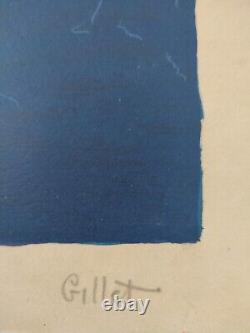
- Index
- Authenticity
- Characteristics
- Genre
- Abstract (92)
- Abstrait (363)
- Art Deco (52)
- Art Déco (109)
- Art Moderne (10)
- Art Naïf (30)
- Art Nouveau (97)
- Cubisme (26)
- Expressionism (53)
- Expressionnisme (162)
- Fauvisme (13)
- Modern (53)
- Moderne (18)
- Naive Art (21)
- Pop Art (40)
- Street Art (62)
- Streetart (87)
- Surrealism (23)
- Surréalisme (103)
- Symbolisme (14)
- Other (1418)
- Style
- Support
- Type
Roger-Edgar GILLET (1924-2004)






Roger-Edgar Gillet was born in Paris in 1924. He was a student at the Boule school and then at the Ecole nationale Supérieure des Arts Décoratifs.
He worked as a decorator but abandoned this activity in 1953. With his wife Thérèse and their four children, they lived in Paris, Saint-Malo, and then in Sens before returning between Paris and Saint-Suliac in the Saint-Malo region. In the 1950s, he was part of the "lyrical abstraction" movement and was presented and supported by Michel Tapié and Charles Estienne. After the Galerie de France, he exhibited at the Galerie Ariel de Jean. Subjects: Abstraction, cities, still lifes, storms.
Gillet seems completely indifferent to any idea of modernism. He paints for pleasure, out of necessity, embodying a cynical view of the world, creating art that pleases him, a human and solid art in a style and technique proven by time. It is probably this indifference to fashion that shocks most about him.
When one appropriates lice as well as storms, crowds, magistrates, naval battles and mutants, cities, owls, it shows a fearlessness, as nothing can stop the tumultuous gesture that traces in the material the constant germinations of the unconscious.
